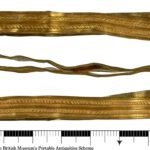An Anglo-Saxon imitation of a late Roman gold solidus discovered in Norfolk last year has been declared treasure. It’s a rough copy of a solidus minted by the Emperor Honorius (r. 393-423 A.D.) that was created long after his death to wear as a pendant.

The imitation Honorius coin has a ribbed suspension loop with four ribs and three grooves soldered to the 12 o’clock position. The wear and tear on the loop indicates the coin was worn as a pendant for a long time, likely with the obverse (the emperor’s bust) showing and the reverse against the body.
Several versions of the genuine solidus were minted in the imperial capitals of Mediolanum (Milan), Ravenna and Constantinople between 394 and 402 A.D. They all portray the draped, cuirassed bust of Honorius wearing a pearl diadem on the obverse. The reverse features the emperor standing with the military standard in his right hand and a winged Victory standing on a globe in his left. Under his left foot is a bound captive. There are small variations between the different strikes of this coin type, and the military standard Honorius holds comes in a couple of forms. Some of the coins have a standard vexillum: a banner draped over a cross-bar mounted to a vertical staff. Others have a labarum, a vexillum with the Chi-Rho symbol on top which was the talismanic symbol Constantine carried.


The vexillum on the Anglo-Saxon imitation looks like a Christian cross inside a square, but the Anglo-Saxons were not Christian yet and in any case even the Christian version of the vexillum doesn’t have just a plain cross slapped inside the banner; it’s the ☧ symbol with the loop of the P on the center top of the banner. It’s quite hard to make out on the small gold coins, and the copyists didn’t have the cultural recognition or skill to make the distinction. The abstract lines that are supposed to convey the winged Victory underscore those limitations. They also removed the captive entirely, probably due to its complexity, but it’s an entertaining thought that they might have rejected the iconography of subjugation since the moneyers who designed these coins would most assuredly have identified them with the barbarian under the emperor’s heel rather than the emperor they identified themselves with.
Dr Marsden, from the Norfolk Historic Environment Service, said this was an era when the Roman Empire, which had become officially Christian by AD380, was “in freefall”.
“We know the Anglo-Saxons of this period are pagan and they are moving in and starting to take over the whole of England, mainly in the east at this moment,” he said.
“It’s slightly ironic, these people are definitely not Christian, yet they are copying a Christian image – the moot point is if they understood the imagery – and they blundered the lettering, so they’re certainly not literate.”
A number of gold coins from the late Western Roman and Byzantine empires converted into pendants in the early Middle Ages have been found in Britain. Genuine Roman coins with suspension loops added by the Anglo-Saxons in the 6th and 7th centuries have been found both as individuals and in coin hoards. Roman gold coins were hard to find at the time and place, hence their desirability as a status symbol instead of simply being used as bullion. Imitations of imperial solidi, siliquae and tremisi were created by the Anglo-Saxons and other Germanic peoples, most prominently the Merovingian Franks whose mints produced almost all of the coins in England at that time. All 37 of the gold coins found in the Anglo-Saxon Sutton Hoo ship burial, four of which were imitations of Byzantine gold coins, came from different mints in Merovingian Gaul.
Dr Marsden said such imitations were “very unusual”.
“We see Roman gold coins being repurposed as coins, occasionally with very similar suspension loops, but here they’ve made the whole thing from scratch,” he said.
Despite the collapse of the empire, the Anglo-Saxons would have come across many impressive Roman buildings, as well as coins and artefacts, and that may be why they want to copy something “so distinctly Roman”.







